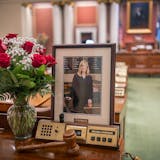(Brad Brolsma, Class of 1969 at Sherburn High School, wrote this piece on community resident George Packard's remarkable presence with the 1970 Sherburn Raiders state basketball champions. The article appeared in the March 11 edition of the Martin County Star.)
March 21 marks the 50th anniversary of Minnesota's very last single-class state basketball championship game. In a genuinely "David vs. Goliath" championship game, the team from the small southwestern town of Sherburn stunned a South St. Paul team that was a favorite to hoist the championship trophy that night. There was also a very compassionate story within this basketball tale. This is that story.
It goes without saying that for most residents of Minnesota, hope springs eternal during the early days of March. For many without ample time or money for travel to tropical wonderlands, these hopes are pretty much fixated on a premature end to winter and the early arrival of much warmer weather.
But it wasn't always like that — especially for the farmers and town folk residing in the counties of southwestern Minnesota. For much of the last century, the calendar turn to March not only brought lofty hopes of an early spring and a swift snow melt, but also frequent coffee shop debates on how the local high school team would fare in the upcoming district, regional and state basketball tournaments. Coaches and fans crafted possible scenarios that would have their favorite team joining just seven other high schools in playing for the state championship at Williams Arena, or "The Barn" as it's affectionately known.
With the southern Minnesota emergence of hockey and school district consolidations still many years away, high school basketball reigned supreme, if only because fielding twelve athletes who were sufficiently adept at dribbling, shooting and rebounding was plausible for even the smallest of these rural communities. During the last eleven years prior to the creation of multiple-class tournaments in 1971, southwestern Minnesota high schools secured four championships, bookended by Edgerton's 1960 championship win over Austin and unbeaten Sherburn's capture of the very last single-class tournament in 1970 — two communities with barely 1,000 inhabitants each.
(There were also back-to-back titles for Marshall in 1963 and Luverne in 1964.)
Much has been written about the Sherburn Raiders' undefeated season and its 78-62 defeat of metro powerhouse and tournament favorite, South St. Paul, in the final game of the state tournament. Whule they are great reads, none has really focused on that year's emergence of the community's most-reclusive resident, George Packard, as the team's most-improbable fan.
This 67-year-old loner was feared by most every kid who walked the streets of Sherburn. As team co-captain Jeff McCarron pointed out, "He scared us as kids … he was kind of this mysterious person about town."

